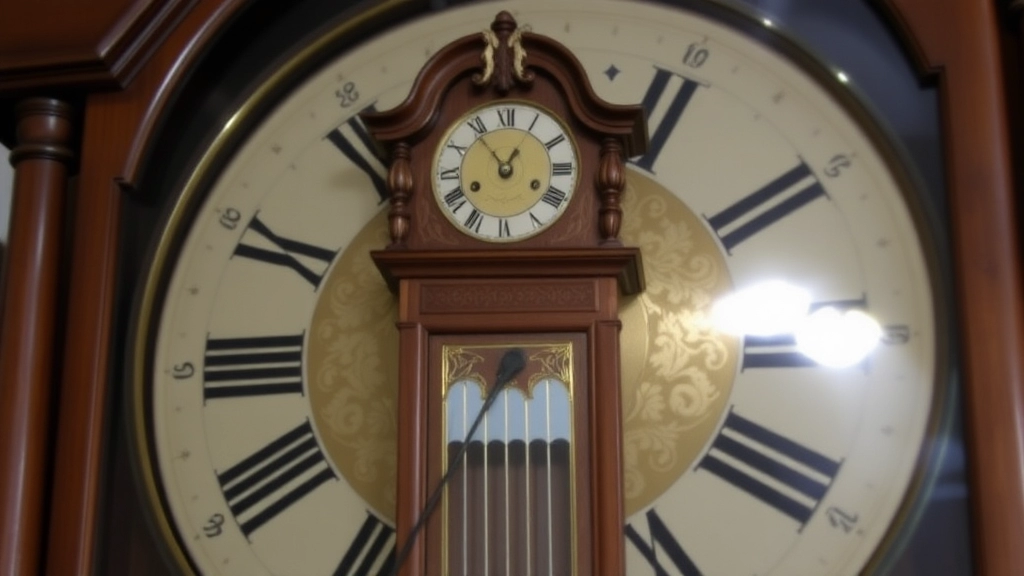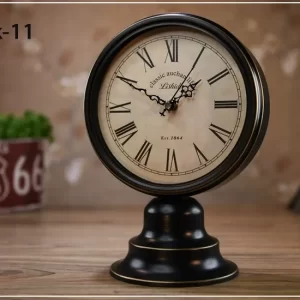Repairing Your Grandfather Clock with MantelClock Studio
Are you struggling to adjust the speed or chime of your grandfather clock? Has your beloved clock gone out of time or not functioning properly? If so, then it may be time for a repair. However, professional repairs can sometimes be costly. If you’re on a budget or enjoy a DIY challenge, then fixing your grandfather clock yourself can be a rewarding experience and a great way to save money. Although challenging, this guide from MantelClock Studio will help you troubleshoot and repair your classic clock.
-
Elegant Black Mantel Clock for Living Room – Silent & Stylish
Original price was: $180.00.$170.00Current price is: $170.00.
How to Adjust the Speed of a Wall Clock
The speed of a wall clock is determined by the length of the pendulum. Modern clocks often use metal pendulums for stability, while older wall clocks used wooden pendulums, which can also keep accurate time if the environment is stable.
Adjusting the Pendulum to Control Speed
- To make your grandfather clock go faster, turn the nut upward to raise the pendulum.
- To slow down, turn the nut downward to lower the pendulum.
Remember:
- The longer the pendulum, the slower the clock goes.
- The shorter the pendulum, the faster the clock goes.
The following is a step-by-step guide to adjusting the clock’s pendulum:
- CHECK ACCURACY: Over a 24-hour period, keep track of when the clock is fast or slow. Set the correct time using a reliable time source such as a cell phone.
- Adjust the nut: If the clock is fast, turn the nut down to lower the pendulum. If it is slow, turn the nut upward to raise the pendulum. Typically, one turn of the nut will adjust the clock about one minute per day.
- Review after 24 hours: observe for another day. If adjustment is still needed, turn at a smaller angle (about half a turn) to fine-tune.
- REPEAT UNTIL PERFECT: Continue until the clock’s speed is perfectly synchronized.
What to do if the speed and chimes are not synchronized
If your grandfather clock’s chimes are out of sync with the hours, most clocks will automatically correct themselves after a reset. If this does not happen, allow the clock to run uninterrupted for at least two hours to allow it to self-correct.
If manual adjustment is required:
- Turn the small screw underneath the pendulum to the left to slow down the pendulum and to the right to speed it up.
- Make fine adjustments and wait a full day to check the results before making further adjustments.
How to Adjust Grandfather Clock Chimes
If your grandfather clock is not chiming correctly, fix it as follows:
- Count the chimes: note how many times the clock chimes.
- Set the hour hand: Move the hour hand so that it matches the number of times it chimes. For example, if the clock chimes three times, set the hour hand to “3”.
- Correcting the minute hand: Rotate the minute hand clockwise so that it points to the correct time.
PRO TIP: During the first hour after adjustment, the clock may make an unusual quarter hour chime, but after that it should automatically return to normal.
To turn off the chime, use the manual lever near the 3 or 9 o’clock position on the clock dial. This lever is usually labeled with the chime option and the word “Silent”.
How to clean your clock
Keeping your desk clock clean is essential to prolonging its life. While regular dusting is important, it should be thoroughly cleaned at least once a year.
Step-by-step cleaning guide:
- PREPARING FOR CLEANING: Carefully remove the pendulum, weights and movement, making sure the chains do not get tangled.
- CLEANING THE CASE: Remove the clock from the wall and clean the back and sides of the case with a soft cloth and a good quality furniture polish.
- Glass panels: open the doors and clean the glass with an ammonia-free cleaner.
- Polishing wood parts: Use wax polish every 2-3 months, but avoid getting it on the glass or moving parts.
- Pendulums and pendulums: dust gently. For lacquered parts, use a soft dry cloth to avoid damage.
- Cleaning the clock face: Use an ostrich feather duster to clean the clock face and hands.
- Careful reassembly: Put the movement, hammers and pendulum back in place. Ensure that the clock remains vertical before restarting.
- Reset the time: turn the hands clockwise to adjust the time precisely.
How to care for your wall clock
Proper maintenance is the key to extending the life of your wall clock. Here are a few important tips from MantelClock Studio:
- Place on a level surface: Make sure your clock is placed on a flat, stable surface to avoid internal damage.
- Keep it running: Don’t let your clock sit idle for long periods of time as this can cause lubricants to dry out and metal parts to deteriorate.
- Clean regularly: Clean dust from the case with a soft, non-abrasive cloth. Avoid using strong cleaning agents that may damage wood or metal.
- Oiling the movement: Oil the movement every two years or when the clock face appears to be running slowly. Oiling reduces friction and extends the life of the clock.
How to oil a desk clock
Before oiling the clock movement, remove the movement to gain access to the front plate. Please follow the steps below:
- Locate the oiling grooves: these small grooves located on the clock dial are where the oiling takes place.
- Apply a small amount: Using a good quality watch oil, fill each groove halfway. Avoid over-application as this will attract dust and dirt.
- Lubricate all necessary parts: Depending on the model of your clock, there may be 35 or more parts that need to be oiled. Refer to the manufacturer’s guidelines to ensure complete coverage.
EXPERT TIP: Always use the watch oil recommended by a professional or the watch manufacturer. Using the wrong oil may do more harm than good.
With these detailed instructions from Mantel Clockworks, you can repair, clean and maintain your vintage clock with confidence that it will run perfectly for generations. If you have any questions about certain steps, feel free to consult a professional or contact us for expert guidance.





